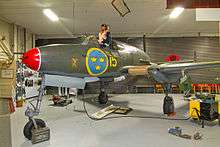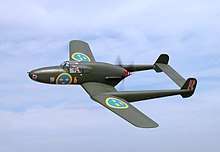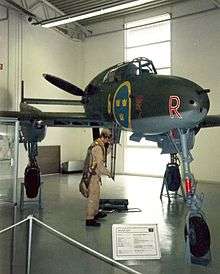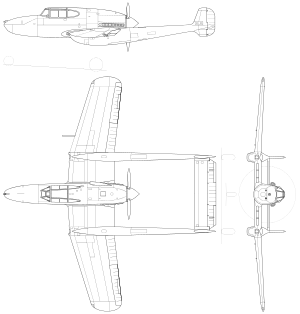SAAB 21
| SAAB 21 | |
|---|---|
 | |
| Saab J 21A-3 | |
| Role | Fighter and attack aircraft |
| Manufacturer | SAAB |
| Designer | Frid Wänström [1] |
| First flight | 30 July 1943 |
| Introduction | 1 December 1945 |
| Retired | 23 July 1954 |
| Status | Retired |
| Primary user | Swedish Air Force |
| Produced | 1945–49 |
| Number built | 298 |
| Developed into | Saab 21R |
The SAAB 21 was a Swedish fighter and attack aircraft designed and manufactured by Swedish aviation company SAAB. It used a relatively unorthodox and visually distinctive combination of a twin boom fuselage and a pusher configuration, giving the aircraft a fairly unique appearance.
Work on the development of the 21 commenced at SAAB following a decision by the Swedish Air Force to embark on a large-scale expansion programme in preparation to fears that the nation might get dragged into the Second World War. The company designed a monoplane twin-boom aircraft, powered by a single Daimler-Benz DB 605B engine that was positioned within the rear of the fuselage, directly behind the pilot, that drove a rear-facing propeller, commonly known as a pusher configuration. This arrangement allowed armaments to be contained within the aircraft's nose section as well as providing the pilot with a high degree of external visibility. To safely enable the pilot to bail out without striking the propeller behind him, it was decided to adopt an ejection seat.
On 30 July 1943, the 21 performed its maiden flight; on 1 December 1945, the first model of the fighter, the J 21A-1 was introduced to service. It was quickly followed by the improved J 21A-2, which featured a heavier armament arrangement, and the B 21A-3, which was a dedicated fighter-bomber mode of the type. In response to interest from the Swedish Air Force in adopting a jet-powered fighter, SAAB developed a conversion of the aircraft, using the British de Havilland Goblin as its powerplant. The jet-powered model of the aircraft was designated as the 21R. During the mid-1950s, less than ten years after its introduction, the 21 was withdrawn from service, having been replaced by a new generation of jet-powered fighters such as the de Havilland Vampire and the Saab 29 Tunnan.
Design and development
Background
In the run up to and during the early stages of the Second World War, the nation of Sweden was concerned that its neutrality in the conflict and its independence as a country could soon come under threat by one or more European nations becoming directly belligerent towards it. As an emergency measure enacted with the aim of increasing both combat preparedness and deterrence against would-be aggressors, the Swedish Air Force embarked upon a major expansion programme during the period of 1939–1941, which included the procurement of foreign-sourced aircraft as well as the indigenous development of new first-rate designs.[2] However, as a consequence of the raging war across Europe, there were only a few nations that were willing to supply fighter aircraft to a small neutral country, while Sweden's own domestic production capability had been deemed to be insufficient until at least 1943. As a stop-gap measure, between February 1940 and September 1941, Sweden received a total of 72 Fiat CR.42 biplane from Italy, which the service designated as the J 11. However, the value of biplanes was rapidly diminishing in the face of increasingly capable monoplane fighters; thus, efforts to acquire more suitable aircraft continued.[3][2]
Meanwhile, Swedish aviation company SAAB had commenced original design studies into possible options for the development of a new fighter aircraft. Many of these options had been based around the use of a British Bristol Taurus engine and, unlike its previous designs, some of the studies explored were highly unconventional.[4] One of the studied configurations was of a monoplane twin-boom aircraft, upon which the Taurus engine was positioned within the rear of the center fuselage, directly behind the pilot, to drive a rear-facing propeller mounted upon the rear of the fuselage, known as a pusher configuration. According to aviation author Bo Widfeldt, this unorthodox design made use of many features that were entirely new to Saab, but possessed several advantages over contemporary fighter aircraft that incentivised their pursuit, such as the ability to centralise a high amount of armaments upon the aircraft's nose section, a high degree of pilot visibility, and serviceability improvements.[4]
While the design study was completed and showed promise, it remained dormant until 1941.[4] That year, in response to pressure to provide a strong air defence component and faced with the prospect of improved imported designs being unavailable due to the war, Sweden decided to undertake an indigenous rearmament programme, which included the development and production of an advanced fighter aircraft. Accordingly, SAAB began studying the means to construct their radical proposal, a prospect which posed several problems that needed to be adequately addressed before proceeding to production.[4] One early problem presented was the ability of the pilot to safely bail out without striking the propeller, which was behind his position. Many different solutions were examined, such as jettisoning either the propeller or the whole engine section via explosive charges prior to bailing out, before it was decided to adopt an ejection seat. It was a new technology, the 21 became one of the first service aircraft in the world to be fitted with an ejector seat.[4]
Design effort

The SAAB 21 had an estimated top speed of 300 MPH, which required a powerful engine to generate sufficient thrust. Early on, it was decided to substitute the Taurus engine for the American Pratt & Whitney R-1830 Twin Wasp radial engine.[4] However, Svenska Flygmotor AB was asked to provide an alternative to the Twin Wasp; options were limited by the very short timescale involved, thus a license-produced engine was the only plausible option. According, a localised version of Germany's new Daimler-Benz DB 605B inline engine, capable of producing 1,475hp, was selected; however, due to the DB 605B's lack of maturity, a great deal of refinement and modification by Swedish engineers was required to de-bug and partially re-design the engine for operational use.[5]
A total of three prototypes were completed to support the programme; only two of these were flyable, while the third was a static airframe for stress testing purposes.[6] On 30 July 1943, the first J 21 prototype conducted its maiden flight, flown by SAAB test pilot Claes Smith. During the takeoff, the wrong flap setting had been selected by the pilot, which resulted in the prototype struggling to get airborne, overrunning the runway and striking a fence at the end of the runway, damaging one of the landing gear legs while also managing to climb away. The maiden flight ended with a successful landing using the undamaged undercarriage units.[7][6]
Further development
Throughout 1945, several different options were explored with the intention of improving the 21's performance.[8] During the first half of the year, the company had planned out a variant of the fighter that would be powered by a Rolls-Royce Griffon engine, capable of producing 2,000hp and giving the 21 a projected top speed of 416mph. Other projects, such as the studied SAAB 27, were also intended to use the Griffon; however, by the end of the year, all work on piston-engine upgrades had been abandoned.[8] In parallel, SAAB and several other Swedish companies had been evaluating the options for the adoption of an innovative, brand new type of engine - the jet engine. Two early studies, designated as RX 1 and RX 2, had been examined, both of which being twin-boom aircraft similar to the 21.[9] Recognising enthusiasm on the part of the Swedish Air Force for a jet-powered aircraft to be made available, during late 1945, SAAB resolved itself to producing a version of the 21 that would harness jet propulsion.[10]
During 1947, at the behest of the Swedish Air Force, the 21 was subject to an extensive rebuilding programme, under which existing aircraft were converted to jet propulsion. The work required each aircraft to be extensively altered, receiving modifications to over 50 per cent of the airframe, tailplane and wing. Most significantly, each of the fighters was furnished with a single British-sourced de Havilland Goblin turbojet engine, which took the place of the DB 605B. The resulting jet-propelled fighter was adopted by the Swedish Air Force and became the service's first jet aircraft. In light of its extensive changes, rebuilt 21s were assigned the designation of J 21R.[11]
Design

The Saab 21 was an unorthodox twin-boom pusher configuration fighter aircraft. It featured a low-mounted wing, a tricycle landing gear arrangement, and was furnished with heavy forward-firing armament.[6] Several recent innovations were incorporated into its design, such as an ejector seat for the pilot; the pusher layout later allowed the type to be readily modified with a turbojet engine as well. The advantages of a pusher design are of an unobstructed forward view for the pilot, while the armament can also be concentrated in the nose; however, a major drawback is difficulty in escaping from the aircraft in an emergency, as the pilot could get drawn into the propeller blades. Saab resolved this issue via the installation of an early ejector seat, developed by Swedish defense firm Bofors, which was developed in conjunction with the fighter itself.[12][1]
The wing of the 21 was based on a SAAB-designed low drag airfoil; as the wings could not reasonable accommodate recesses for the main landing gear when retracted, alcoves were instead provided within the tail booms, directly aft of the rear wing spar.[6] Other systems, such as the center-section fuel tanks, were incorporated into the wing, which complicated their design considerably. To minimise drag, the coolers and ducts for the engine were housed within the contours of the airfoil between the fuselage and tail booms.[6]
The armament initially consisted of two 13.2 mm automatkanon m/39A (akan m/39A) autocannons in the wings and two more 13.2 mm akan m/39A autocannons and a 20 mm akan m/41A in the nose. On the A-2 model the 20 mm akan m/41 was replaced with a belt fed Bofors designed 20 mm akan m/45. On the J 21A-3 (later designated A 21A) it was possible to load rockets and bombs of various sizes and types. Later in the Saab 21's service life the 13.2 mm akan m/39 autocannons were rebarreled to fire american 12.7x99 mm ammunition due to economics. This was not a bad change though as the 12.7 mm AP-rounds had better performance than the 13.2 mm AP rounds and the Saab 21 was basically only viable as an attacker after WWII due to the jet era.
Operational history
On 1 December 1945, deliveries of the initial production model of the fighter, designated as the J 21A-1, commenced to the Swedish Air Force.[6] Overall, 54 J 21A-1 fighters were constructed at SAAB's main plant in Trollhättan; deliveries of this model continued until 5 December 1946, by which point it had been superseded by improved models.[13] The J 21A-1 model was quickly followed by another 124 and 119 examples of the improved J 21A-2, which featured a revised armament arrangement, and the B 21A-3, a dedicated fighter-bomber, respectively. The type was used by the Swedish Air Force alone. In total, 298 J 21As were constructed prior to the production line being closed down during 1948.[13]
During December 1945, F 8 Barkarby became the first fighter unit to receive the J 21.[13] During the following year, other units of the Swedish Air Force, such as F 9 Säve, also began to receive the type. However, within less than four years, some squadrons that had received the type were being re-equipped with a new generation of fighters harnessing jet propulsion for greater speed, such as the de Havilland Vampire.[14] Despite the original intention for the type to be principally in air defence roles, in service, the J 21 was utilized mainly in the bomber role. According to Widfeldt, officials were often confused by its unconventional design and had doubts over the fighter's use and effectiveness.[8]
In response to feedback that sought alternative options, the Swedish Air Board approached SAAB with a request to conduct design studies into the proposed development of a front-engine replacement, which was referred to as the J 23.[8] This aircraft shared the same DB 605B engine as the J 21, but had a more traditional appearance; Widfeldt observed that the J 23 concept was visually similar to the North American P-51 Mustang, he also noted that its projected performance was beneath that of the existing J 21, which had been a key factor in the decision to persist with efforts to improve the existing fighter instead. Over time, the Swedish Air Force had become increasingly interested in jet propulsion and, as early as 1945, SAAB had been examining prospective modifications of the airframe to accommodate a jet engine in place of its piston engine.[8] While production line J 21A series aircraft were first selected for conversion, the initial piston-engine version continued in production in five series "batches" that were completed in 1948–49. As a result of the conversion programme, the iJ 21A was phased out after 1954.[12][15]
Variants

- J 21A-1
- First production series of fighter version. 54 built between 1945 and 1946, retired in 1949.
- J 21A-2
- Second and third production series of fighter version (62 aircraft each built between 1946 and 1947). Aircraft had better avionics and was armed with a Swedish 20 mm gun. Retired between 1953 and 1954.
J 21A-3 (later designated A 21A)
- First and second production series of attack version (66 aircraft each built between 1947 and 1949). Aircraft was basically J 21A-2 equipped with bomb aiming sight, was able to use two RATO rockets, and was armed with unguided rockets and bombs.
- J 21B
- Planned version armed with three 20 mm nose guns, radar in the starboard boom, improved aerodynamics and Daimler-Benz DB 605E or Rolls-Royce Griffon engines.[12] None built.
Operators
Survivors
Three aircraft are preserved;
- A 21A-3, serial 21286 rebuilt into an A 21R, on permanent static display at the Swedish Air Force Museum.[16]
- A 21A-3, serial 21311, on permanent static display as a J 21A-3 at F 15 Söderhamn Flygmuseum.[16]
- A 21A-3, serial 21364, on permanent static display at the Swedish Air Force Museum.[16]
Specifications

Data from official SAF booklet/manual: Beskrivning över fpl typ 21A, häfte 1 (description over airplane type 21A, booklet 1) & Beskrivning över fpl typ 21A, häfte 6 kap L. Beväpning (description over airplane type 21A, booklet 6, chapter L. armament)
General characteristics
- Crew: one
- Length: 10.45 m (34 ft 3 in)
- Wingspan: 11.6 m (38 ft 0 in)
- Height: 3.97 (13 ft 0 in)
- Wing area: 22.2 m² (238.87 ft²)
- Empty weight: 3,250 kg (7,165 lb)
- Loaded weight: 4,150 kg (9,149 lb)
- Max. takeoff weight: 4,413 kg (9,730 lb)
- Powerplant: 1 × Daimler-Benz DB 605B, built by SFA. liquid-cooled, supercharged, 60° inverted V12 engine, 1,085 kW (1,455 hp / 1,475 PS)
Performance
- Maximum speed: 650 km/h, 350 knots, 403 mph (fighter config), 560 kmh, 302 knots, 347 mph (attacker config)
- Cruise speed: 495 km/h (265 knots, 308 mph)
- Range: 750 km (466 mi)
- Service ceiling: 11,000 m (36,090 ft)
- Rate of climb: 15 m/s (2,950 ft/min)
Armament
J 21A-1
- 1× 20 mm akan m/41A with a 60 round drum magazine in the nose
- 2x 13.2 mm (0.53 in) akan m/39A with 350 rpg in the nose
- 2x 13.2 mm (0.53 in) akan m/39A with 325 rpg in the wings
J 21A-2 & A-3
- 1× 20 mm akan m/45 with 140 rounds in the nose
- 2x 13.2 mm (0.53 in) akan m/39A with 350 rpg in the nose
- 2x 13.2 mm (0.53 in) akan m/39A with 325 rpg in the wings
Loudouts (only A-3) (max 700 kg)
Inner wing mount (the inner wing mount only held rockets at an early stage and was later replaced by the outer wing mount for carrying rockets)
- 4x 50 kg minbomb m/37 general purpose bomb
- 4x 50 kg sprängbomb m/42 fragmentation bomb
- 4x 50 kg sprängbomb m/47 fragmentation bomb
- 4x 50 kg bombkapsel m/43 cluster bomb
- 4x 8 cm pansarraket m/46 AP-rocket (RP-3 rocket with Shot, 25 lb., "AP" Mk II head)
- 4x 15 cm sprängraket m/46 HE-rocket (RP-3 rocket with Shell, H.E. 60 lb., "SAP" No. 2 Mk Ihead)
Outer wing mount
- 8x 8 cm pansarraket m/46 AP-rocket (RP-3 rocket with Shot, 25 lb., "AP" Mk II head)
- 8x 15 cm sprängraket m/46 HE-rocket (RP-3 rocket with Shell, H.E. 60 lb., "SAP" No. 2 Mk Ihead)
- 8x 14,5 cm pansarsprängraket m/49A & B HEAT-rocket (Bofors 10.3 cm rocket with 14,5 cm HEAT head)
- 8x 15 cm sprängraket m/51A & B HE-rocket (Bofors 10.3 cm rocket with 15 cm HE head)
- 2x 18 cm halvpansarraket m/49A & B APHE-rocket (Bofors 18 cm rocket with 18 cm APHE head. At the start used primarily against ships but in the end against basically everything else.)
Belly
- 1x 250 kg minbomb m/37 general purpose bomb (central fuze with bent fins)
- 1x 250 kg minbomb m/40 general purpose bomb (central fuze with straight fins)
- 1x 250 kg minbomb m/50 general purpose bomb (nose & central fuze with straight fins)
- 1x 500 kg minbomb m/41 general purpose bomb (2 central fuzes with straight fins)
- 1x 600 kg minbomb m/50 general purpose bomb (nose fuze & 2 central fuzes with straight fins)
Wingtips
- 2x vingspetstank drop tanks (Could be armed in flight as incendiary bombs. They were also tested with napalm.)
See also
Related development
Aircraft of comparable role, configuration and era
- Kyushu J7W
- RMI-8
- Ambrosini SS.4
- Mansyū Ki-98
- Vultee XP-54 Swoose Goose
- Curtiss XP-55 Ascender
- Fokker D.XXIII
- XP-56 Black Bullet
Related lists
References
Notes
Info about armament taken from the Swedish version of the article
Citations
- 1 2 Erichs et al. 1988, p. 22.
- 1 2 Cattaneo 1967, pp. 10-12.
- ↑ "J 11 – Fiat C.R. 42 (1940–1945)." Archived 5 February 2007 at the Wayback Machine. Avrosys.nu. Retrieved: 22 July 2009.
- 1 2 3 4 5 6 Widfeldt 1966, p. 3.
- ↑ Widfeldt 1966, pp. 3-4.
- 1 2 3 4 5 6 Widfeldt 1966, p. 4.
- ↑ Widfeldt 1966, p. 261.
- 1 2 3 4 5 Widfeldt 1966, p. 7.
- ↑ Widfeldt 1966, pp. 7-8.
- ↑ Widfeldt 1966, p. 8.
- ↑ Erichs et al. 1988, p. 23.
- 1 2 3 Fredriksson, Urban. "Saab J 21/A 21/A 21R." canit.se, 13 December 2000. Retrieved: 10 January 2010.
- 1 2 3 Widfeldt 1966, p. 6.
- ↑ Widfeldt 1966, pp. 6-7.
- ↑ Widfeldt 1966, pp. 8-9.
- 1 2 3 Widfeldt 1966, p. 12.
Bibliography
- Billing, Peter. "A Fork-Tailed Swede." Air Enthusiast Twenty-two, August–November 1983. Bromley, Kent, UK: Pilot Press, 1983.
- Cattaneo, Gianni. The Fiat CR.42 (Aircraft in Profile number 170). Leatherhead, Surrey, UK: Profile Publications Ltd., 1967. No ISBN.
- Erichs, Rolph, Kai Hammerich, Gudmund Rapp et al. The Saab-Scania Story. Stockholm: Streiffert & Co., 1988. ISBN 91-7886-014-8.
- This Happens in the Swedish Air Force (brochure). Stockholm: Information Department of the Air Staff, Flygstabens informationsavdelning, Swedish Air Force, 1983. No ISBN.
- Widfeldt, Bo. The Saab 21 A & R (Aircraft in Profile number 138). Leatherhead, Surrey, UK: Profile Publications, 1966. No ISBN.
- Wilson, Stewart. Combat Aircraft since 1945. Fyshwick, AU: Aerospace Publications, 2000. ISBN 1-875671-50-1.
External links
| Wikimedia Commons has media related to Saab J21. |
- Saab 21 story, SE: Canit .